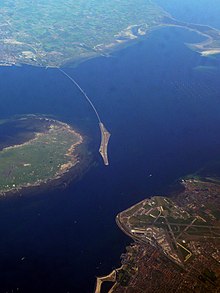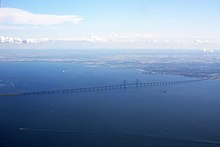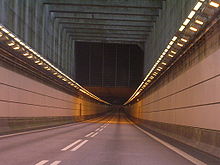This is an old revision of this page, as edited by Yngvadottir (talk | contribs) at 13:47, 11 September 2015 (Reverted most of edit by 2.110.54.51 of 2 July: pointy replacement of instances of Ö. 2 others changed for consistency. Web page title indeed has Ø; fixed fix there. Reinstated Ø̈resundsbron as hybrid name but as below, company uses Øresundsbron.). The present address (URL) is a permanent link to this revision, which may differ significantly from the current revision.
Revision as of 13:47, 11 September 2015 by Yngvadottir (talk | contribs) (Reverted most of edit by 2.110.54.51 of 2 July: pointy replacement of instances of Ö. 2 others changed for consistency. Web page title indeed has Ø; fixed fix there. Reinstated Ø̈resundsbron as hybrid name but as below, company uses Øresundsbron.)(diff) ← Previous revision | Latest revision (diff) | Newer revision → (diff) Bridge in Denmark and Malmö, Sweden| Öresund Bridge Øresund Bridge | |
|---|---|
 | |
| Coordinates | 55°34′31″N 12°49′37″E / 55.57528°N 12.82694°E / 55.57528; 12.82694 |
| Carries | Four lanes of European route E20 Double-track Oresund Line |
| Crosses | Øresund strait (the Sound) |
| Locale | Copenhagen, Denmark and Malmö, Sweden |
| Official name | Öresundsbron, Øresundsbroen |
| Characteristics | |
| Design | Cable-stayed bridge |
| Total length | 7,845 metres (25,738 ft) |
| Width | 23.5 metres (77.1 ft) |
| Longest span | 490 metres (1,608 ft) |
| Clearance below | 57 metres (187 ft) |
| History | |
| Designer | Jorgen Nissen, Klaus Falbe Hansen, Niels Gimsing and Georg Rotne |
| Engineering design by | Ove Arup & Partners Setec ISC Gimsing & Madsen |
| Constructed by | Hochtief, Skanska, Højgaard & Schultz and Monberg & Thorsen |
| Opened | 1 July 2000 |
| Statistics | |
| Daily traffic | ca. 17,000 road vehicles daily |
| Toll | 335 DKK, 400 SEK or 46 EUR |
| Location | |
The Öresund or Øresund Bridge (Template:Lang-da Template:IPA-da, Template:Lang-sv Template:IPA-sv, joint hybrid name: Ø̈resundsbron) is a double-track railway and motorway bridge across the Öresund strait between Scania (southernmost Sweden) and Denmark. The bridge runs nearly 8 kilometres (5 miles) from the Swedish coast to the artificial island of Peberholm, which lies in the middle of the strait. The crossing of the strait is completed by a 4 km (2.5-mile) underwater tunnel, called the Drogden Tunnel, from Peberholm to the Danish island of Amager. The term Øresund Bridge often includes this tunnel.
The Øresund Bridge is the longest combined road and rail bridge in Europe, and connects two major metropolitan areas: Copenhagen, the Danish capital city, and the major Swedish city of Malmö. It connects the road and rail networks of the Scandinavian Peninsula with those of Central and Western Europe. A data cable also uses the bridge to carry all Internet data transmission for Finland.
The international European route E20 crosses via road, the Oresund Line via railway. The construction of the Great Belt Fixed Link, connecting Zealand to Funen and thence to the Jutland Peninsula, and the Øresund Bridge have connected Central and Western Europe to Scandinavia by road and rail. The Øresund Bridge was designed by the Danish engineering firm COWI. The justification for the additional expenditure and complexity related to digging a tunnel for part of the way, rather than raising that section of the bridge, was to avoid interfering with air traffic from the nearby Copenhagen Airport, to provide a clear channel for ships in good weather or bad, and to prevent ice floes from blocking the strait. The Øresund Bridge crosses the border between Denmark and Sweden, but in accordance with the Schengen Agreement and the Nordic Passport Union, there are usually no passport inspections. There are random customs checks at the entrance toll booths entering Sweden, but not when entering Denmark.
The Øresund Bridge received the 2002 IABSE Outstanding Structure Award.
Name
In Denmark and Sweden, the bridge is usually referred to as Øresundsbroen and Öresundsbron respectively. The bridge company insists on Øresundsbron, a compromise between the two languages. Since the crossing is composed of a bridge, an artificial island and a tunnel, it is sometimes called the "Öresund Link" or the "Öresund Connection" (Danish: Øresundsforbindelsen, Swedish: Öresundsförbindelsen).
History
The concepts of bridges over the Öresund (152m DKK) and Storebælt (257m DKK) were proposed and calculated around 1936, if not earlier. The construction of the Øresund Bridge, which was undertaken by a joint venture of Hochtief, Skanska, Højgaard & Schultz and Monberg & Thorsen, began in 1995, and was finished 14 August 1999. Crown Prince Frederik of Denmark and Crown Princess Victoria of Sweden met midway across the bridge-tunnel on 14 August 1999 to celebrate its completion. Its official dedication took place on 1 July 2000, with Queen Margrethe II, and King Carl XVI Gustaf as the host and hostess of the ceremony. Because of the Roskilde Festival tragedy the night before, which had claimed the lives of 9 people, including 3 Danes and 3 Swedes, the ceremony was opened with a minute's silence. The bridge-tunnel was opened for public traffic later that day. On 12 June 2000, two weeks before the dedication, 79,871 runners competed in Broloppet, a half marathon from Amager, Denmark, to Skåne, Sweden.
In spite of two schedule setbacks – the discovery of 16 unexploded World War II bombs on the seafloor and an inadvertently skewed tunnel segment – the bridge-tunnel was finished three months ahead of schedule.
Although traffic between Denmark and Sweden increased by 61 percent in the first year of the bridge being open, the crossing was not used as much as expected (probably because of the high tolls) but since 2005, there has been a rapid increase in traffic. This may have been caused by Danes buying homes in Sweden to take advantage of lower housing prices in Malmö and commuting to work in Denmark. In 2012, to cross by car cost DKK 310, SEK 375 or € 43, with discounts of up to 75% available to regular users. In 2007, almost 25 million people travelled over the Øresund Bridge: 15.2 million by car and bus and 9.6 million by train. By 2009, the figure had risen to 35.6 million by car, coach or train.

Link features
The bridge

At 7,845 m (25,738 ft), the bridge covers half the distance between Sweden and the Danish island of Amager, the border between the two countries being 5.3 km (3.3 mi) from the Swedish end. The structure has a mass of 82,000 tonnes and supports two railway tracks beneath four road lanes in a horizontal girder extending along the entire length of the bridge. On both approaches to the three cable-stayed bridge sections, the girder is supported every 140 m (459 ft) by concrete piers. The two pairs of free-standing cable-supporting towers are 204 m (669 ft) high allowing shipping 57 m (187 ft) of head room under the main span, but most ships' captains prefer to pass through the unobstructed Drogden Strait above the Drogden Tunnel. The cable-stayed main span is 491 m (1,611 ft) long. A girder and cable-stayed design was chosen to provide the specific rigidity necessary to carry heavy rail traffic, and also to resist large accumulations of ice.
The bridge experiences occasional brief closures during very severe weather, such as the St. Jude storm of October 2013.
Due to high longitudinal and transverse loads acting over the bridge and to accommodate movements between the superstructure and substructure, it has bearings weighing up to 20t each, capable of bearing vertical loads up to 96,000 kN in a longitudinal direction and up to 40,000 kN in transverse direction. The design, manufacturing and installation of the bearings were carried out by the Swiss civil engineering firm Mageba.
Vibration issues, caused by several cables in the bridge moving under certain wind and temperature conditions, were combatted with the installation of compression spring dampers installed in pairs at the centre of the cables. Two of these dampers were equipped with laser gauges for ongoing monitoring. Testing, development and installation of these spring dampers was carried out by specialists European Springs.
Peberholm
Main article: PeberholmThe bridge joins Drogden tunnel on the artificial island of Peberholm (Pepper Islet). The Danes chose the name to complement the natural island of Saltholm (Salt Islet) just to the north. Peberholm is a designated nature reserve built from Swedish rock and the soil dredged up during the bridge and tunnel construction, approximately 4 km (2.5 mi) long with an average width of 500 m (1,640 ft). It is 20 m (66 ft) high.
Drogden Tunnel

The connection between Peberholm and the artificial peninsula at Kastrup on Amager island, the nearest populated part of Denmark, is through the 4,050 m (13,287 ft) long Drogden Tunnel (Drogdentunnelen). It comprises a 3,510 m (11,516 ft) undersea tube tunnel plus 270 m (886 ft) entry tunnels at each end. The tube tunnel is made from 20 prefabricated reinforced concrete segments – the largest in the world at 55,000 t each – interconnected in a trench dug in the seabed. Two tubes in the tunnel carry railway tracks, two carry roads and a small fifth tube is provided for emergencies. The tubes are arranged side by side.
Rail transport


The rail link is operated jointly by the Swedish SJ and Danish railways via DSBFirst on a commission by Skånetrafiken and other county traffic companies (that also sell tickets) and the Danish transport agency. A series of new dual-voltage trains was developed, linking the Copenhagen area with Malmö and southern Sweden as far as Gothenburg and Kalmar. SJ operates X2000 and InterCity trains over the bridge, with connections to Gothenburg and Stockholm. DSB operates trains to Ystad that connect directly to a ferry to Bornholm. Copenhagen Airport at Kastrup has its own railway station close to the western bridgehead. Trains operate every 20 minutes, once an hour during the night, in both directions. An additional couple of Øresundstrains are operated at rush hour, and 1–2 SJ trains and DSB trains per hour and direction every other hour. Freight trains also use the crossing.
The rail section is double track 1,435 mm (4 ft 8+1⁄2 in) standard gauge and capable of speeds of up to 200 kilometres per hour (120 mph), slower in Denmark, especially in the tunnel section. There were challenges related to the difference in electrification and signalling between the Danish and Swedish railway networks. The solution chosen is to switch the electrical system from Swedish 15 kV, 16.7 Hz to Danish 25 kV, 50 Hz before the eastern bridgehead at Lernacken in Sweden. The line is signalled according to the standard Swedish system across the length of the bridge. On Peberholm the line switches to Danish signalling, which continues into the tunnel.
Swedish trains run on the left, Danish on the right. Initially the switch was made at Malmö Central Station, a terminus at that time. After the 2010 inauguration of the Malmö City Tunnel connection, a flyover was built at Burlöv, north of Malmö, where the two southbound tracks cross over the northbound pair. The railway in Malmö thus uses the Danish standard.
Costs and benefits


The cost for the Oresund Connection, including motorway and railway connections on land, was 30.1 billion DKK (~US$5.7bn) according to the 2000 year price index, with the cost of the bridge paid back by 2037. In 2006, Sweden began spending a further SEK 9.45 billion on the Malmö City Tunnel as a new rail connection to the bridge. It was completed in December 2010.
The connection will be entirely user-financed. The owner company is owned half by the Danish state and half by the Swedish state. This owner company has taken loans guaranteed by the governments to finance the connection and the user fees are the only income for the company. After the increase in traffic, these fees are enough to pay the interest and begin paying back the loans, which is expected to take about 30 years.
Taxpayers have not paid for the bridge and the tunnel, but tax money has been used for the land connections. Especially on the Danish side, the land connection has domestic benefit, mainly connecting the airport to the railway network. The Malmö City Tunnel has the benefit of connecting the southern part of the inner city to the rail network and allowing many more trains to and from Malmö.
According to The Öresund Committee, the bridge has made a national economic gain of 57 billion DKK, or 78 billion SEK (~US$11bn) on both sides of the strait by increased commuting and lower commuting expense. The gain is estimated to be 6.5 billion SEK per year but this could be increased to 7.7 billion by removing the three biggest obstacles to integration and mobility, the two largest being that non-EU nationals in Sweden are not allowed to work in Denmark and that many professional qualifications and merits are not mutually recognised.
Cultural references
- The Øresund Bridge was the setting for the 2011 Swedish/Danish TV crime drama The Bridge.
- It was used as a symbol for the connection between Sweden and the rest of Europe at the Eurovision Song Contest 2013.
- It was the inspiration behind the 2014 song "Walk Me to the Bridge" by Manic Street Preachers from their album Futurology.
Environmental effects
The underwater parts of the bridge have become covered in marine organisms and act as an artificial reef.
See also
- Øresund Region
- HH Tunnel, a proposed second Øresund fixed link connecting Helsingør and Helsingborg
- List of bridge–tunnels
- List of road-rail bridges
References
- Notes
- "New Baltic data cable plan unfolding". Yle yhtiönä. 11 December 2013. Retrieved 12 December 2013.
According to current plans, the undersea optic fibre cable would run directly from Germany to Finland. Haavisto said that the project could make Finland a significant international data hub. So far, all data transmission to Finland has taken place via the Öresund Bridge, that is through Denmark and Sweden.
- Marstrand, Wilhelm. "Det store vej- og broprojekt" Ingeniøren, 14 March 1936. Accessed: 2 December 2014.
- The final span over the Öresund
- "Danmark og Sverige landfast" (in Danish). DR. Retrieved 26 March 2011.
- "Øresundsbroen indviet". B.T. (in Danish). Ritzau. 1 July 2000. Retrieved 26 March 2011.
- "Broåbning i tragediens skygge". Berlingske (in Danish). Ritzau. 1 July 2000. Retrieved 14 February 2015.
- "90.000 løbere over Øresundsbroen". B.T. (in Danish). Ritzau. 12 June 2000. Retrieved 26 March 2011.
- Claus F. Baunkjær. "Cautious traffic assumptions for the Fehmarnbelt project" Fehmarn Belt Fixed Link, 28 March 2013. Accessed: 6 October 2013.
- "Øresundsbron | Bättre resultat trots den ekonomiska avmattningen". Uk.oresundsbron.com. Retrieved 2013-03-24.
- "Traffic numbers" All years (.XLS spreadsheet) Øresundsbron. Accessed: 6 October 2013.
- "Nyheder - Indland - Stormen lukker Řresundsbroen" (in Danish). jv.dk. Retrieved 2013-11-18.
- Mageba Archived 2014-01-02 at the Wayback Machine
- "Compression springs stopped vibration on the Øresund bridge". Retrieved 20 March 2015.
- OECD Territorial Reviews OECD Territorial Reviews: Oresund, Denmark/Sweden 2003 OECD Territorial Reviews Series. OECD Publishing. 2003. p. 38. ISBN 978-92-64-10080-0.
{{cite book}}:|first=missing|last=(help) - Öresund Committee paper
- Öresundsbron ger mångmiljardvinster
- Robert Barry, "Bleeding Edge: Nicky Wire on Futures, Futurism and Futurology," TheQuietus.com, 27 May 2014.
External links
| External videos | |
|---|---|
- Official English website
- Øresund Link at Structurae
- Øresund Bridge at Structurae
- Øresund Tunnel at Structurae
- Øresund bridge project information from Road Traffic Technology
- Impossible Bridges: Denmark to Sweden (MegaStructures documentary, 2006)
- Video on Arup's website and on Youtube showing Arup Legends: Jorgen Nissen
- Live WebCam
| Malmö | ||
|---|---|---|
| History |  | |
| Districts | ||
| Buildings and landmarks | ||
| Parks | ||
| Places of worship | ||
| Culture | ||
| Galleries and museums | ||
| Education | ||
| Sports venues | ||
| Transport | ||
| Trans-European Transport Network (TEN-T) | |
|---|---|
| Corridors |
|
| Infrastructures | |
| |
55°34′N 12°51′E / 55.57°N 12.85°E / 55.57; 12.85
Categories:- Cable-stayed bridges in Denmark
- Cable-stayed bridges in Sweden
- Railway bridges in Denmark
- Railway bridges in Sweden
- International bridges
- Road-rail bridges
- Bridge-tunnels
- Bridges completed in 2000
- Transport in Copenhagen
- Buildings and structures in Copenhagen
- Buildings and structures in Malmö
- Scania
- Toll bridges
- Toll tunnels
- Viaducts
- Connections across the Baltic Sea
- Undersea tunnels
- Denmark–Sweden border crossings
- Oresund Line
- Transport in Malmö